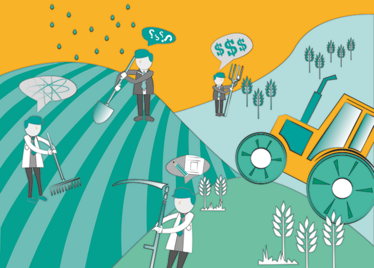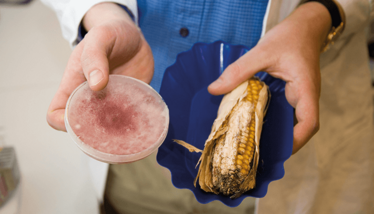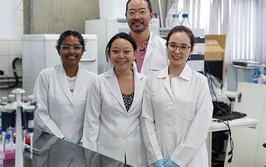Joining Forces: Breaking the Mold
In our ongoing series profiling collaborations between industry and academia, we look at a partnership finding better ways to detect dangerous fungal toxins in our food.
Franz Berthiller, John Lee |

Tell us about your project...
Franz Berthiller: Mycotoxins are poisonous metabolites produced by fungi, which can pose a serious food safety threat. A famous fungal metabolite is aflatoxin B1 – it’s one of the most carcinogenic compounds known to mankind, and we’re still finding it in food. John approached us because BOKU is a leading center focused on researching mycotoxins, with expertise from analytical scientists, toxicologists, and plant biologists. Mycotoxins are highly diverse and so we used to have separate methods for each mycotoxin, with different extraction, clean-up, and measuring modes. In 2005, I published the first method that could analyze nine mycotoxins at once. John wanted to work with us to come up with easier methods for mycotoxin testing, allowing Agilent to offer labs a “mycotoxin testing kit” including the instrument, method, standards and set-up. So Agilent offered to provide us with a high-end tandem quadrupole LC-MS instrument and technical support to help us in that goal.
John Lee: It’s academics like Franz who truly understand not just how to make methods more efficient, but also to increase their scope – they’re the people we want to work with so we can offer truly cutting-edge workflows.
How did the two teams work together?
JL: Thomas Glauner is an LC-MS expert in Agilent and it was he who started working closely with Franz’s group.
FB: Thomas was our major collaborator during that project; whenever we had questions about the software or struggled with settings, Thomas was just a call or email away. And we had several productive meetings at our lab and Agilent’s facility in Germany. Sometimes in projects like these, only one partner publishes – but this is truly a joint work and, as such, our publications include authors from both groups.
What are the aims of the collaboration?
FB: Our first goal was to develop accurate methods for measuring regulated mycotoxins. The regulation of mycotoxins is a complicated issue, and Europe has the strictest regulations in the world. We developed a method to measure all of the regulated mycotoxins found in solid foodstuffs, using stable isotopes. It was published in 2012 (two years after the collaboration began) and looks set to remain the gold standard for quantification for years to come (1). Using sensitive modern instruments, this method allows us to measure mycotoxins at the regulated level even in baby food – for which the acceptable limit is lowest of all.
JL: What was really neat about Franz’s idea of using stable isotopes is that the resulting workflow is so simple – it’s easy for any lab to replicate at minimal cost. Usually, when you’re analyzing compounds at the very low levels necessary for mycotoxins, you have to do extensive sample clean-up to compensate for matrix issues. With stable isotopes, you can correct for matrix issues, and simplify the sample prep. The sample preparation workflow that Franz and his team developed is very straightforward, and therefore productive.
Earlier this year, a lab in China published an application note with Agilent describing how they had extended Franz’s method from 11 to 16 mycotoxins in cereals (2). This shows how Franz’s work is not just of academic interest, but of real interest to people doing food testing around the world.
FB: In academia it’s easy to feel that once you publish a paper, that’s the end of the story. It’s great to hear that people as far away as China are adopting our approach.
What was the next phase of the project?
FB: Besides the increasing sensitivity of instruments, a key trend in analytical chemistry is multiplexing. There are tens of thousands of fungal metabolites; we don’t know the toxicity of the vast majority of those compounds, but we do know that several hundred have some degree of toxicity. So the second phase of our collaboration was to develop a multi-mycotoxin method that can screen for hundreds of metabolites (3) – preferably without the need for standards. This second phase started with tandem quadrupole LC-MS but ultimately led to the use of high-resolution mass spectrometry, which allows you to scan for anything that ionizes. We used an Agilent QTOF instrument and set up a workflow to screen for over 400 mycotoxins (4), which was challenging for a couple of reasons; first, we had a new instrument to get used to; second, we needed new types of workflows. The idea was to make a library for most of our targets using our specialized collection of standards and isolates. That would then allow any user of that instrument model to screen for the same compounds, even though they wouldn’t have access to the standards (5).

What were the greatest benefits of collaboration?
FB: As well as access to powerful technology and next-level technical support, we appreciated the opportunities we were given to disseminate our work. We have had the chance to talk at several scientific conferences, and share our experiences in a WebEx organized by Agilent.
JL: I agree that dissemination is key – making sure that new methods are communicated in public conferences, but also through Agilent-organized events, like the meeting we run every spring for the food and environmental testing community (6). We want to communicate a whole workflow to our customers – and we can only do that through collaboration with experts like Franz.
Franz’s work also informs our own efforts, allowing us to go back and develop the technology further.
What kind of challenges are typically encountered in such collaborations, and how do you deal with them?
JL: One of the challenges of any collaboration is simply that it takes time. Especially when you’re trying to create something for the first time – like a library and databases for hundreds of mycotoxin compounds! Great work doesn’t happen overnight, and it can be a challenge to keep focused, stay motivated, and keep driving things forward.
Another challenge is the need for bravery. The screening approach that Franz developed goes far beyond regulated compounds, and some may argue, “What’s the point?” But the reality is that there could be harmful mycotoxin compounds that we simply don’t know about yet. As well as testing for regulated compounds, we need labs to assess what else is out there. It’s all about pushing the frontiers.
FB: I would go one step further and say we are contributing to a paradigm change in toxicology. There is a famous saying: “the dose makes the poison.” Traditionally, we have first identified toxic compounds, and then measured levels; as our tools improve and we are able to screen hundreds of compounds, we might be able to do it the other way round – it might not be feasible to assess the toxicity of every compound, but we can start by assessing compounds that occur at high levels.
What’s next?
JL: Franz is now working on yet more innovative workflows looking at “masked” mycotoxins – metabolites made in the plant that don’t show up in testing but may still be toxic once ingested by an animal or human. (7)
FB: This new line of work is something we never anticipated, but the degree of freedom that we enjoy in this partnership has made it possible. We have the flexibility to look at a wide range of issues, and that’s a really nice way to work. (7)
- E Varga et al., “Stable isotope dilution assay for the accurate determination of mycotoxins in maize by UHPLC-MS/MS”, Anal Bioanal Chem, 402, 2675–2686 (2012).
- Agilent Technologies, “Simultaneous determination of 16 mycotoxins in cereals using an Agilent Triple Quadrupole LC/MS system and e-Method”. Available at: bit.ly/2iM7dah. Accessed December 2017.
- E Varga et al., “Development and validation of a (semi-)quantitative UHPLC-MS/MS method for the determination of 191 mycotoxins and other fungal metabolites in almonds, hazelnuts, peanuts and pistachios”, Anal Bioanal Chem, 405, 5087–5104 (2013).
- Agilent Technologies, “Screening and verifying mycotoxins in food with Q-TOF LC/MS and an accurate mass library.” Available at: bit.ly/2iJm59t. Accessed December 2017.
- Agilent Technologies, “Mycotoxins and related metabolites personal compound database and library”. Available at: bit.ly/2zJyP35. Accessed December 2017.
- Agilent Technologies, “Environmental and Food Meeting. Available at: bit.ly/2hsaBTn. Accessed December 2017.
- AV Nathanail et al., “Metabolism of the Fusarium mycotoxins T‑2 toxin and HT‑2 toxin in wheat”, J Agric Food Chem, 63, 7862−7872 (2015).
Associate Professor, University of Natural Resources and Life Sciences, Vienna (BOKU), in Tulln, Austria.
John Lee, Global Food Market Manager - Agilent Technologies.

















